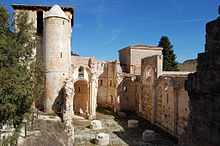- San Pedro de Arlanza
-
San Pedro de Arlanza (located in Hortigüela, Burgos) was a monastery in north central Spain. Founded in 912, it has been called the "cradle of Castile" (cuna de Castilla). It was abandoned in 1841 during the government of Juan Álvarez Mendizábal, when ecclesiastical properties were roundly redistributed.
San Pedro's two purported founding documents, preserved in twelfth-century cartulary, were issued one by Count Fernán González and his wife, Sancha, and the other by Fernán's mother and brother, Muniadona Ramírez and Ramiro González, with Count Gonzalo Téllez and his wife, Flamula. Both documents suffer from certain inconsistencies and anachronisms that have cast doubts on their authenticity, especially that of Fernán González. It was probably forged to give the monastery a more illustrious lineage than it could prove to have. The copy of the charter of Gonzalo Téllez is more likely to be based on reality, since Gonzalo is known to have been active in 912.[1] Fernán González and Sancha were buried at San Pedro, however, and remained there until the dispersal of the monastic community in 1841 necessitated the removal of their sarcophagi to the collegiate church of San Cosme y San Damián at Covarrubias.
The present ruins of the church are those of the building begun in 1080. It had three naves and three semicircular apses in the Romanesque style. Later modifications in the Gothic style transformed the outward appearance, but some of its eleventh-century capitals have been preserved. Among the ruins the three apses still stand and the tower, erected towards the close of the twelfth century, part of the cloisters and the chapter house, as well as the double-aperture and the tympanum above the main façade. The portal of the church was transferred to the National Archaeological Museum of Spain in 1895. A large Romanesque tomb, said to belong to the legendary Mudarra González, was moved to the Cathedral of Burgos, and some frescoes have been brought to the Metropolitan Museum of Art in New York and to the Museu Nacional d'Art de Catalunya.
Notes
- ^ Escalona Monge, Julio (2001), Transformaciones sociales y organización del espacio en el alfoz de Lara en la alta Edad Media, Madrid: Universidad Complutense, ISBN 84-8173-035-1
External links
- (Spanish) Universidad Complutense de Madrid. La expansión del dominio monástico de San Pedro de Arlanza a lo largo del siglo XI.
- (Spanish) Universidad Complutense de Madrid. Formación y primera expansión del dominio monástico de San Pedro de Arlanza. Siglo X.
- (Spanish) Dialnet. El cuerpo occidental de la iglesia de San Pedro de Arlanza. Propuesta de reconstrucción histórica.
Categories:- Christian monasteries established in the 10th century
- 1841 disestablishments
- Monasteries in Castile and León
Wikimedia Foundation. 2010.

